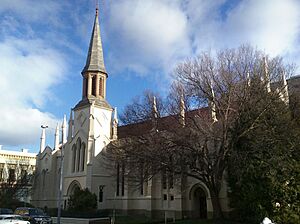St Andrew's Kirk, Launceston facts for kids
Quick facts for kids St Andrew's Kirk |
|
|---|---|
| St Andrew's Presbyterian Church | |

St Andrew's Kirk from St John Street
|
|
| 41°26′10″S 147°08′15″E / 41.43617°S 147.13762°E | |
| Location | St John Street, Launceston, Tasmania |
| Country | Australia |
| Denomination | Presbyterian |
| History | |
| Status | Church |
| Founded | 16 October 1849 |
| Founder(s) | Sir William Thomas Denison |
| Dedication | Saint Andrew |
| Dedicated | 5 December 1850 |
| Architecture | |
| Functional status | Active |
| Architect(s) |
|
| Architectural type | Church |
| Style | Gothic Revival |
| Years built |
|
| Groundbreaking | 1849 |
| Construction cost | A£3,956 |
| Specifications | |
| Capacity | 320 people |
| Length | 38.4 metres (126 ft) |
| Nave width | 14.4 metres (47 ft) |
| Number of spires | 1 |
| Materials | Sandstone, brick, stucco |
| Administration | |
| Parish | Launceston |
| Presbytery | Bass |
| Division | Tasmania |
St Andrew's Kirk is a historic Presbyterian church in Launceston, Tasmania, Australia. It is located on St John Street. This church is an important part of Launceston's history. It was the second Presbyterian church built in the city. The first one was the Scotch National Church, built in 1831.
Contents
History of St Andrew's Kirk
Early Days of the Church
In 1831, Scottish people in Launceston decided to build a church. They built the Scottish National Church on Charles Street. It cost £400. The first minister was Reverend John Anderson.
In 1835, a group called the Presbytery of Van Diemen's Land met there. This was one of the oldest church groups in Australia. By 1848, the church had many members. It became clear that a bigger church was needed.
Building the New Church
People wanted a new, larger church closer to the city center. They asked the Lieutenant-Governor, Sir William Thomas Denison, for land. They chose a spot where an old watch house used to be.
The church committee asked for designs for a church that could seat 700 people. Many designs were sent in. The winning design was by William Henry Clayton. His plan was for a church that could seat 320 people. Clayton later became a famous architect in New Zealand.
His design was in the Gothic Revival style. It used local bricks covered in stucco. It also had sandstone decorations and a tall spire. The church had entrances on Patterson and St John Streets.
On October 16, 1849, the first stone of the church was laid. Lieutenant-Governor Denison placed it. A time capsule was also put inside. It held newspapers and coins from that time.
William Tyson, a church member, built the church. It cost A£3,956. The building was finished in 15 months. St Andrew's Kirk officially opened on December 5, 1850. The church was completely paid for within four years.
Adding to the Building
As more people joined the church, new parts were added. One big addition was St Andrew's Chambers. This was a two-story building in the Gothic Revival style. It filled a space between the church and another building.
The Chambers had a kitchen, a caretaker's apartment, and a Sunday School Hall. It also had offices. In 1973, a nearby building was torn down. The exposed side of St Andrew's Chambers looked unfinished. So, the city decided to remove the Chambers.
City Architect William Clennett designed a new extension. This new part had three levels. It included office space, a kindergarten, and a choir room. There was also a church lounge and a Sunday School Hall. This new section cost $111,138. It opened in October 1974 without any debt.
Later, in 1986, a new entrance area was added. More seating was put on the inside balcony. Glass screens were added in the foyer. In 1996, new sound and lighting equipment was installed.
Damage to the Church
Between 1883 and 1885, Tasmania and Victoria felt many earth tremors. These tremors were linked to the eruption of Krakatoa. On July 14, 1884, a tremor caused damage in Launceston. Many chimneys and plaster walls were affected.
This tremor moved some of the stone decorations on the church roof. One stone fell to the ground with great force. It made a 6-inch deep hole in the dirt. Luckily, it missed a group of children waiting for Sunday School.
Decades later, on December 30, 1929, another tremor happened. This one caused one of the church's spires to fall off.
The Church Organ
In 1933, the church got a new organ. This organ was first built in 1860 for a doctor in Campbell Town. Before coming to St Andrew's Kirk, it was used in Hobart and Latrobe.
In 1961, the organ was rebuilt and made larger. In 2005, parts of the organ were updated again.
See also
- Presbyterian Church of Australia


